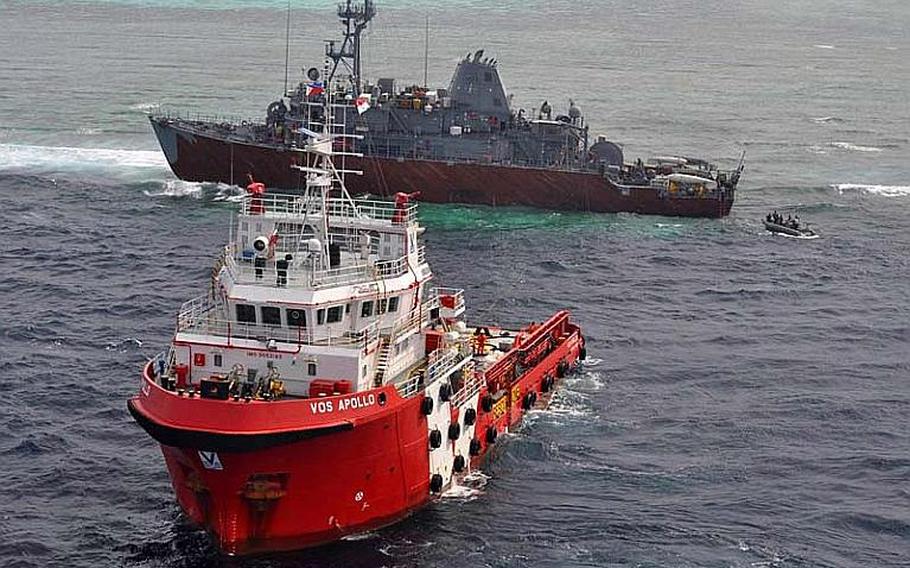
Malaysian tug Vos Apollo prepares for defueling operations near the grounded USS Guardian on Jan. 24, 2013, while a U.S. Navy small boat approaches with a salvage team. The U.S. Navy contracted Vos Apollo to assist with removing fuel from the mine countermeasures ship, which ran aground on the Tubbataha Reef in the Sulu Sea on Jan. 17. No fuel has leaked since the grounding and all of the approximately 15,000 gallons onboard Guardian was safely transferred to Vos Apollo during two days of controlled defueling operations on Jan. 24 and Jan. 25. (Geoffrey Trudell/U.S. Navy, Flickr)
SASEBO NAVAL BASE, Japan — The Navy’s assessment of damage sustained by a protected reef off the Philippines when the USS Guardian ran aground last month has been rejected by officials who manage the World Heritage Site.
The Tubbataha Protected Area Management Board announced the rejection over the weekend, saying the Navy broke previous agreements by excluding them from a 10-day assessment of the reef by a Navy biologist. They also claimed the Navy barred them from inspecting the site themselves.
Navy officials in Manila and with the Pacific Fleet in Hawaii could not be reached for comment. Details of the assessment were not available.
“The U.S. Navy assessment has been rejected because it involved none of the Philippine personnel that are in the area, despite the fact that earlier agreements with the U.S. Navy specify the involvement of local enforcers,” park administrator Angelique Songco told Stars and Stripes on Monday.
“Their biologist was in the park for 10 days but did not once contact marine park rangers or Coast Guard personnel for a joint assessment. Our rangers have been unable to complete their work because they are not allowed in the vicinity or told to stay at least five meters away from the ship.”
Philippine Coast Guard officials denied having knowledge of a Navy assessment of the damage.
No one was injured when the Guardian ran aground around 2:25 a.m. on Jan. 17 while transiting the Sulu Sea after a port visit in Subic Bay. The crew of 79 was removed the next day as a safety precaution.
Over the last three weeks, the 224-foot minesweeper has slid around on Tubbataha Reef, a World Heritage Site, damaging the reef and causing hull breaches. Its compartments have taken on water as crews worked to remove hazardous materials such as oil and wastewater and secure items for removal.
The grounding sparked protests outside the U.S. Embassy, and Philippine officials have called for the U.S. Navy and government to pay stiff fines.
Navy officials announced last week the ship was a complete loss and the only option to minimize damage to the reef was to cut up the Guardian and remove it in sections, a process expected to take over a month. The Navy sent their salvage plan to the Philippine Coast Guard for approval while they awaited the arrival of two heavy-lift cranes contracted out of Singapore.
The first crane, Smit Borneo, arrived Sunday, the Navy’s onsite spokesman, Lt. Frederick Martin, said Monday. It was unclear when the second will reach the area, but the Navy must wait for the salvage plan’s approval before they can proceed.
On Tuesday, Philippine Coast Guard officials tried to iron out the final details of the plan with all of the stakeholders involved, Coast Guard Cmdr. Armando Balilo said. He said the final sticking point is that the plan called for the salvage vessel to be anchored on the reef.
“The salvage plan is still being discussed because there are some reservations,” Balilo said. “In principle, it has already been approved.”
Songco said the site has become littered with rubble.
“Fiberglass sheets that covered the ship are strewn all over the area,” she said. “[Tuesday], the salvor will present the salvage plan, then we will have more understanding of the process and its potential impacts on our very short — three-month — tourism window.”
The U.S. government has apologized repeatedly.
“In view of damage caused by the USS Guardian accident at Tubbataha Reef, the United States has expressed its regrets and is prepared to provide appropriate compensation to the Republic of the Philippines,” the U.S. Embassy in Manila said Sunday while laying out plans to make things right.
“In addition to compensation, the U.S. government is planning a number of other activities which will underscore its commitment to Tubbataha’s recovery and the protection of the marine resources of the Philippines.”
Those include a $100,000 grant to a Philippine university to support coral restoration research at the reef, a round table in the next two weeks with local conservation experts to discuss options for conservation and restoration, development of a rehabilitation plan, funding of a site survey to improve the park ranger station, and efforts to improve cartographic information on the reef.
Vice Adm. Scott Swift, commander of the U.S. Navy’s 7th Fleet, is investigating the grounding.